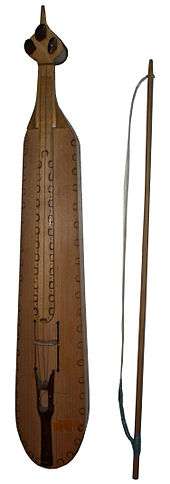Kemenche
Kemenche or kemençe is a name used for various types of stringed bowed musical instruments having their origin in the Eastern Mediterranean, particularly in Armenia, Greece, Iran, Turkey, Azerbaijan[1], and regions adjacent to the Black Sea. These instruments are folk instruments, generally having three strings and played held upright with their tail on the knee of the musician.[2] The name Kemençe derives from the Persian Kamancheh, and means merely "small bow".[3]

.jpg)
Variations
The Kemençe of the Black Sea (Turkish Karadeniz kemençesi, Greek Pontic kemenche, Pontic lyra, Ποντιακή λύρα) is a box-shaped lute (321.322), while the classical kemençe (or Klasik kemençe, Armudî kemençe, Politiki lyra; Greek: Πολίτικη Λύρα) is a bowl-shaped lute (321.321).
Other bowed instruments have names sharing the same Persian etymology include the kamancheh (or Kabak kemane in Turkish), a spike lute (321.31), and the Cappadocian kemane, an instrument closely related to the kemenche of the Black Sea with added sympathetic strings.
See also
References
- McCollum, Jonathan (2014). "Kamancha." New Grove Dictionary of Musical Instruments. Second Edition. Oxford University Press. ISBN 9780199743391.
- Hugo Pinksterboer, Tipbook: Cello (2002), p. 106.
- "Middle East Focus" (PDF). TheStrad.com: 50–52. July 2007.
The Persian word for bow is kaman, and kamancheh is the diminutive form.
External links
| Wikimedia Commons has media related to Kemenches. |